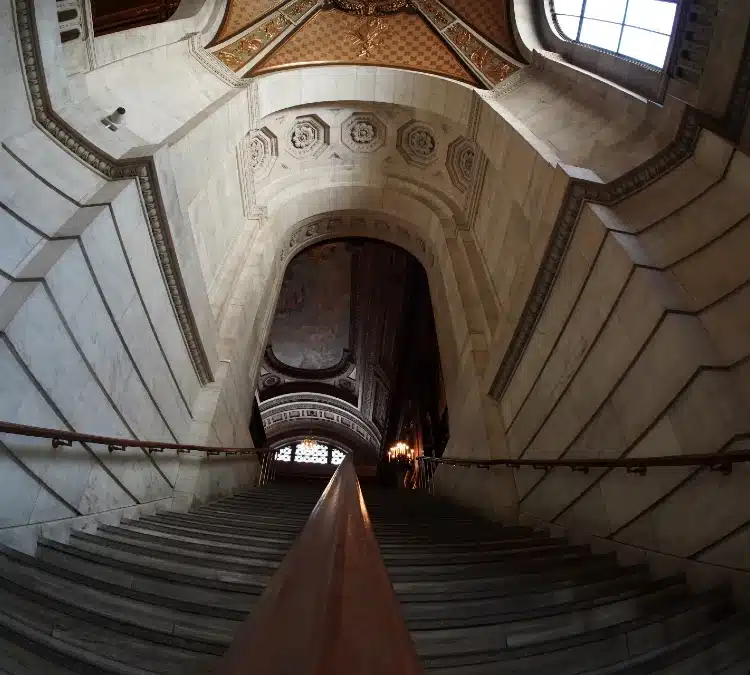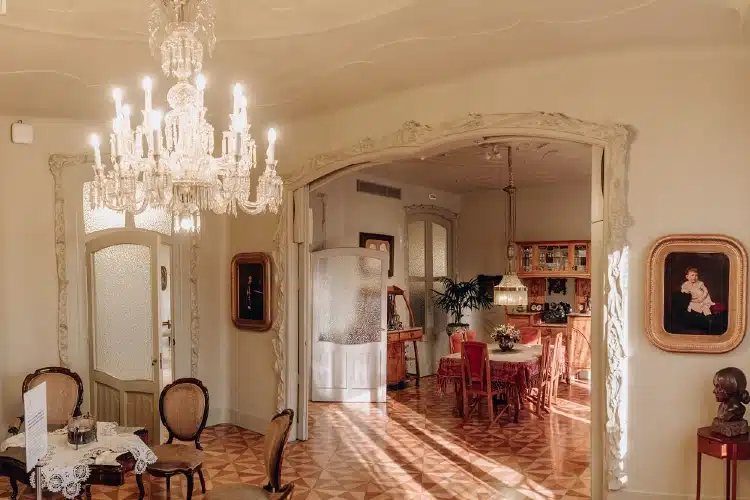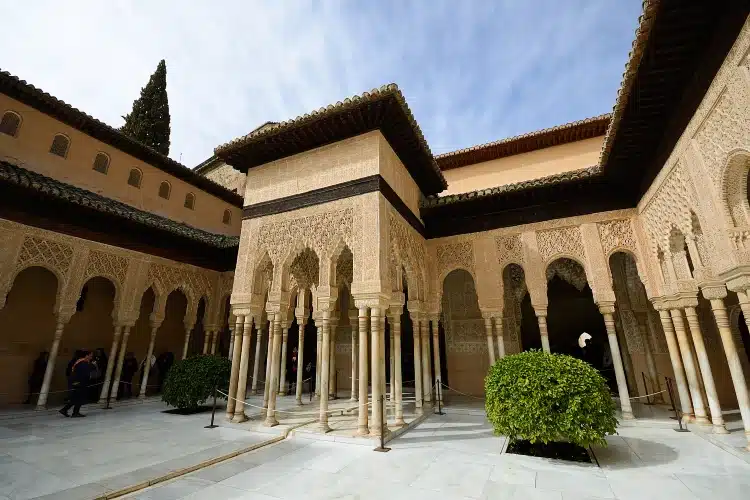Casa Mila is a unique architectural gem in Barcelona, Spain that draws millions of visitors annually.
Commissioned in 1906 by Pere Mila and Roser Segimon, it was the last private residence designed by the famous architect Antoni Gaudi.
Its architecture initially raised eyebrows with its distinctive wavy walls and twisty balconies, but it quickly became a beloved attraction.
The name La Pedrera, meaning “the stone quarry,” reflects its rugged appearance.
Today, Casa Mila La Pedrera is a testament to Gaudi’s brilliance and a must-visit attraction in Barcelona.
This handy guide will help you know everything about this attraction, including Casa Mila tickets.
Who was Antoni Gaudi?
Antoni Gaudí was a renowned Spanish architect known for his innovative and distinctive architectural style, often characterized by organic and nature-inspired designs.
He is most famous for his masterpiece, the Sagrada Família Basilica, and many other buildings in Barcelona, including the Three Houses of Gaudi.
Where is Casa Mila?
Address – Provença, 261-265, 08008 Barcelona, Spain. Get Directions
La Pedrera Casa Mila is located in Barcelona, Catalonia, Spain. It can be found in Provença, on the corner of Passeig de Gràcia.
About Casa Mila
Official name: La Pedrera
Architect: Antoni Gaudi
Year of opening: 1912
Opening hours: 9 am to 6.30 pm and 7 pm to 9 pm
Entrance ticket price: From €25
Closest subway stop: Diagonal
Best time to visit: Early morning or late afternoon
Suggested duration: 1.5 to 2 hours
Annual Visitors: 1 million+
Must-see: The Roof Terrace, Whale Attic, Courtyard, and Pedrera Apartments.
Why is Casa Mila so popular
- Built in 1912, Casa Mila’s unique architecture, featuring wavy walls, twisted iron balconies, and rooftop whistle chimneys, sets it apart.
- It was the last private residence designed by Antoni Gaudí, adding to its historical significance.
- It was designated a UNESCO World Heritage Site in 1984
- Visitors are drawn to its stunning rooftop terrace, adorned with unique chimneys, ventilation towers, and stairwells.
- An evening rooftop jazz concert is very popular among visitors. It is one of the must-do things while visiting Casa Mila at night.
Tickets to Casa Mila
The Casa Mila skip-the-line ticket offers an opportunity to explore one of Antoni Gaudí’s masterpieces without the hassle of waiting in long lines.
Visitors can marvel at the unique architecture, including the iconic rooftop with its whimsical chimneys, and learn about Gaudí’s life at the Espai Gaudi exhibition.
Adults (3 to 64 years old) can secure their visit for just €25. Seniors (65+ years) and students enjoy a discounted rate of €19.
Children (7 to 12 years old) can join the adventure for half the price of €13. Infants (up to 6 years old) can visit for free.
(Tickets Currently Unavailable)
What to see inside Casa Mila
Inside Casa Mila, you’ll find beautiful courtyards, Espai Gaudi, a visual room, the Pedrera Apartment, an exhibition hall, and the Alhambra Museum.
The Facade and Iron Balconies

Instead of traditional load-bearing walls, Casa Mila’s large limestone blocks and curved iron beams create a unique facade.
This allows for a greater degree of freedom in the design of the balconies, which are all different and feature a variety of intricate ironwork.
Gaudí’s attention to detail is evident in every aspect of the balconies. The wrought iron is sculpted into various organic forms, such as leaves, flowers, and animals.
Some balconies even have moving parts, such as the main floor, which features a pair of iron gates that open and close to regulate the amount of sunlight entering the apartment.
The Beautiful Courtyard

You’ll discover meticulously planned courtyards adorned with floral motifs, mythical scenes, and colorful details inside Casa Mila.
Casa Milà was built as two individual apartment blocks. However, the buildings intersect at the courtyards, creating a flowing, wave-like effect.
These interconnected courtyards provide natural light and ventilation, adding to the building’s charm.
Visitors often spend a lot of time looking up at the murals and taking pictures, as this is one of the most photographed places in the building.
The Rooftop

The rooftop features wavy floors that crawl up the walls and 28 chimneys resembling carnival masks, Darth Vader, and the Grim Reaper.
When you visit the rooftop, you will feel like you have entered an alternate reality.
The curves of the building make it look like it is wobbling. You can also enjoy stunning views of the city and the Sagrada Família from the rooftop.
Visitors can explore this rooftop marvel, which hosts nighttime audiovisual and jazz music shows.
Casa Milà Attic

The attic of Casa Milà was originally used as the building’s laundry room. Today, it houses the Espai Gaudí, a museum dedicated to the great architect.
The museum features plastic models of Gaudí’s other famous works, art, videos, and an explanation of how Barcelona’s nature influenced him.
It is divided into seven different areas, one dedicated entirely to Casa Milà.
The exhibits in this area explain the building’s construction and design and showcase Gaudí’s innovative use of materials and construction techniques.
Tourists love Casa Milà for its 270 parabolic arches supporting the roof terrace above.
Some visitors have described it as feeling like a walk inside an undulating whale skeleton.
Espai Gaudi – A Visual Room

Espai Gaudi is a visual delight located on the attic’s fourth floor, featuring 270 parabolic arches.
It also hosts an extensive exhibition dedicated to Antoni Gaudi’s life and work.
Sculptures, models, photographs, and videos offer insights into his architectural genius.
This space within the building also serves as a venue for shows and musical concerts.
Adorned with murals and Gaudi’s wrought ironwork, it’s a place where culture and art come to life.
Pedrera Apartment

The fourth floor of Casa Milà (La Pedrera) has two different apartments.
One is used for audiovisual presentations about the time period between Tragic Week (1909) and the World’s Fair (1929).
The other apartment is the famous La Pedrera apartment, where Pere Milà lived with his family.
This apartment has been preserved strictly as it was when Milà moved in, offering a unique glimpse into upper-class life in the early 20th century.
The bedrooms, living room, bathroom, kitchen, and children’s toys are all intact, seemingly frozen in time.
Alhambra Museum

Casa Mila’s Alhambra Museum is located on the attic floor of Casa Milà.
The museum is dedicated to the work of Antoni Gaudí and features a collection of models, plans, and drawings of his most famous works, including Casa Mila.
This is also home to artifacts from Gaudi’s life and work, including his furniture, tools, and personal belongings.
It also features several interactive exhibits, allowing visitors to learn more about Gaudi’s work and creative process.
Casa Mila Night Experience

This extraordinary adventure offers a visit to Gaudi’s masterpiece under the stars.
From rooftop jazz concerts to mesmerizing light shows, it’s a magical way to discover La Pedrera’s architectural beauty in the dark.
The night experience also includes a glass of cava, a sparkling wine popular in Spain. This is a great way to relax and enjoy the atmosphere.
Related article: La Pedrera Night Experience
Casa Mila architecture

Casa Milà is constructed from over 6,000 stone blocks connected by metal components.
Its façade features a variety of geometric shapes and organic forms, giving the building a dynamic and sculptural appearance.
The balconies are made of wrought iron and feature intricate designs.
Casa Mila Interiors has apartments with open-plan layouts and load-bearing walls.
Even the ceilings are adorned with beautiful reliefs and inscriptions.
The attic houses the Gaudi Exhibition, which offers visitors a glimpse into the architect’s life and work.
Related article: Architecture of Casa Mila
Things to know before visiting Casa Mila
- Smoking is prohibited.
- Outside food is not allowed inside Casa Mila.
- Only guide dogs are allowed on the property.
- Flash photography is prohibited.
- Phone calls are not allowed.
- Rucksacks are not allowed, but there’s a luggage area for storage.
- Casa Mila is wheelchair-accessible.
- A special ticket discount for adults, students, and children is available.
So, book your Casa Mila tickets now and secure your spot to visit this architectural wonder.
FAQ’s
1. What is special about Casa Milà?
Casa Mila is unique due to its distinctive wavy walls, amazing architecture by Antoni Gaudí, and stunning rooftop terrace.
2. Is Casa Milà worth going inside?
Yes, it is definitely worth exploring the interior of Casa Mila, which showcases Gaudí’s impressive architecture, featuring beautiful courtyards, an Espai Gaudi exhibition, and more.
3. Is Casa Milà free?
No, it is not free. There is starting at €25 for adults. Children, seniors, and students can avail a special discount on Casa Mila tickets.
4. What’s inside Casa Milà?
Inside Casa Mila Barcelona, you’ll find beautiful courtyards, Espai Gaudi (a visual room), the Pedrera Apartment, an exhibition hall, and the Alhambra Museum.
5. Which Casa is the best to visit in Barcelona?
Casa Mila La Pedrera is one of the best places to visit in Barcelona due to its unique architecture and cultural significance.
6. Who lives in Casa Milà now?
Casa Mila is no longer a private residence. It is open to the public as a museum and cultural center, so no one lives there.
7. Can you stay in Casa Milà?
No, one can’t stay inside Casa Mila, as it is a historical site and a functional museum.
8. Why was Casa Milà built?
La Pedrera Casa Mila was built as a private residence for Pere Mila and his wife, Roser Segimon. It is a testament to Gaudí’s architectural brilliance.
9. How many people visit Casa Milà each year?
Casa Mila receives over 1 million visitors annually. It is one of the most visited attractions in Barcelona, Spain.
10. How long do people spend at Casa Milà?
Visitors typically spend about 1.5 to 2 hours exploring Casa Milà’s interior, but you can spend longer if you wish to dive deep into its architectural wonders and exhibitions.
Featured Image: Tripadvisor.in



